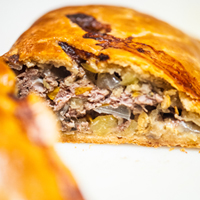Cornish Pasty Dough
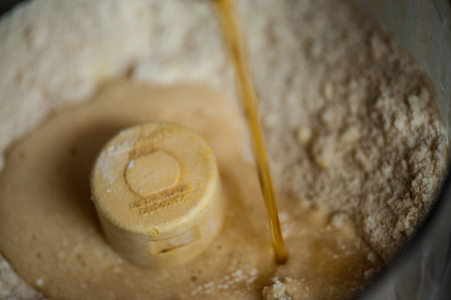 Originating in Britain, the Cornish Pasty is a hand pie, usually savory, with a sturdy dough enclosing a filling of steak, potatoes, carrots, onions, and seasonings. These pasties were designed to be a full meal that would hold up in a workman’s pocket until lunch without any protection other than the crust. Cornish Pasties also differ from other hand pies like calzones or empanadas in the fact that the raw filling cooks while the pastry itself cooks, sealing all of the flavors and nutrients inside an edible wrapper. This also differentiates this Cornish Pasty Dough from other dough recipes.
Originating in Britain, the Cornish Pasty is a hand pie, usually savory, with a sturdy dough enclosing a filling of steak, potatoes, carrots, onions, and seasonings. These pasties were designed to be a full meal that would hold up in a workman’s pocket until lunch without any protection other than the crust. Cornish Pasties also differ from other hand pies like calzones or empanadas in the fact that the raw filling cooks while the pastry itself cooks, sealing all of the flavors and nutrients inside an edible wrapper. This also differentiates this Cornish Pasty Dough from other dough recipes.
This dough recipe creates a sturdy crust that will hold the filling together while baking and provide a flaky texture to the outside of the hand pie. Bread flour increases the gluten to create a more durable crust, while barley flour adds flavor and some texture. For a more tender chew, use a lower protein pastry flour.
Filling options start with From the Garden Pasty Filling for a vegetarian version of a Cornish Pasty. Lamb Cornish Pasty Filling plays with the idea of steak, being just as meaty, with a richer flavor. Another option is a fusion flavored pasty, using pork and the flavors of the South West | Tex Mex to make a unique cross the pond hand pie; Southwestern Pork Pasty Filling. These are just a few of the possibilities for a Cornish Pasty. Try other Sweet Fillings or Savory Fillings to make your own creation.
To seal these Cornish Pasties and give them a wonderful browned sheen, they are brushed with Egg Wash. This helps seal the Cornish Pasty Dough tight, holding all the juices and filling in the hand pie, while also creating a wonderful crust to the pasty.
Adapted from BeerAdvocate Magazine: Cuisine à la Bière | Apr 2017 | Issue #123
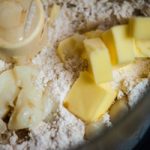
| Servings | Prep Time |
| 4 servings | 20 minute |
| Cook Time |
| 45- 60 minute |
|
|

|
This Cornish Pasty Dough is used to make English Pasties or Hand Pies . It's more durable than other dough recipes and filled with different ingredients to become a lunch or main course.
|
-
2 cup
flour, bread such as King Arthur, Special Bread Unbleached Flour, 5 lb
-
1 cup
flour, barley such as Bob's Red Mill Barley Flour
- 1 teaspoon salt, kosher
- 1/2 cup butter, unsalted preferably European style, cold and cubed
- 1/2 cup fat, rendered, such as duck or pork lard, cold
- 1 cup beer, such as Mild, ESB, Bitter
- 1 recipe From the Garden Pasty Filling recipe HERE
- or
- 1 recipe Lamb Cornish Pasty Filling recipe HERE
- or
- 1 recipe Southwestern Pork Pasty Filling recipe HERE
- In the bowl of a food processor, add the high gluten and barley flours, then the salt. Seal the bowl with its lid, and pulse to mix the ingredients together. Then cut the butter and fat into the flour mixture, pulsing the food processor until there are small pea-sized lumps. Over-mixing the butter and fat into the dough will make a less flaky crust.
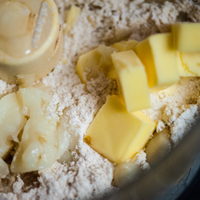
- Next, add enough ice cold beer to form a ball of dough. Do not over mix or add too much beer or the pastry will be tough. Pour with a light hand.
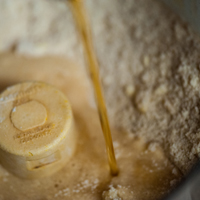
- Remove the dough from the bowl and place onto a floured workspace. Lightly knead it into a ball. Cover with plastic wrap and refrigerate for 1 hour to rest the gluten and hydrate the flour.
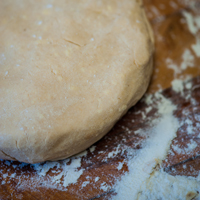
- After an hour or more, remove the dough from the cold box. Divide it into four equal-sized balls for large pasties or eight pieces for small pasties.
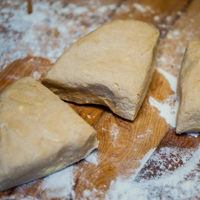
- Use a rolling pin on a floured surface to roll out each dough ball into a circle with a thickness of about 1/8 inch. For four pieces of dough, the rounds will measure 10 inches in diameter, or 7 inches with eight dough balls. Use enough flour to keep the dough from sticking to the surface of the rolling pin.
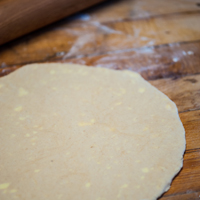
- Next, brush the surface of the pastry with the Egg Wash.
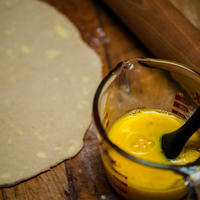
- Add the filling of choice to half of the dough round, but don’t overstuff the pasty, leaving an edge for the opposite edge to stick to. Fold the opposite side of the dough over the filling and, making your hand into a cup, lightly press down to remove any air and create a half moon shape.
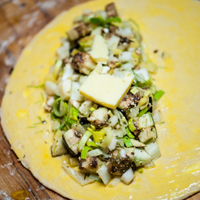
- To seal the pasty, start at one side of the crescent and fold the dough over, then onto itself, over and over, making a nice pattern around the edge. Or use the tines of a fork to press the two dough layers together. Be sure the dough is sealed, to prevent leaking during cooking. Use different crimping styles or patterns on the edges to help identify each filling. Place onto a baking sheet lined with parchment paper or a Silpat. Repeat the steps above until the dough is gone.
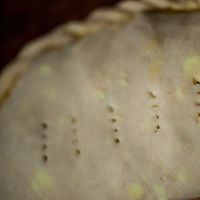
- Refrigerate the pasties for 20 – 30 minutes to chill them, helping to prevent the dough from shrinking during the cooking process.
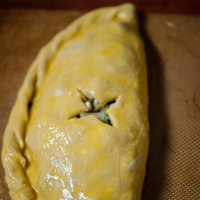
- Preheat the oven to 400°F | 204°C. Make a few small cuts on top of the pasty to allow the steam to vent; these too can be used for flavor identification. Brush the surface and edges with an even layer of Egg Wash. Bake pasties for 45 – 60 minutes, looking for a nice golden brown crust, and a fully cooked, warm filling. (The internal temperature should be around 200°F | 93°C). Allow to cool slightly before serving.
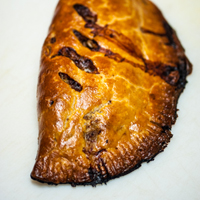
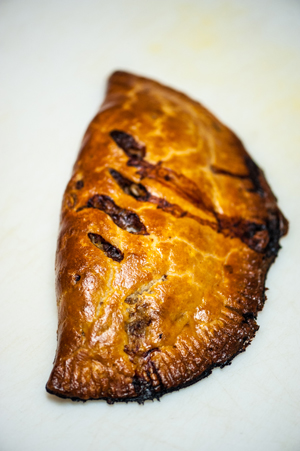
Note: To make a vegetarian | vegan version of this crust, substitute vegetable shortening for the fat or lard.
Other Cornish Pasty | Hand Pie Recipes:

